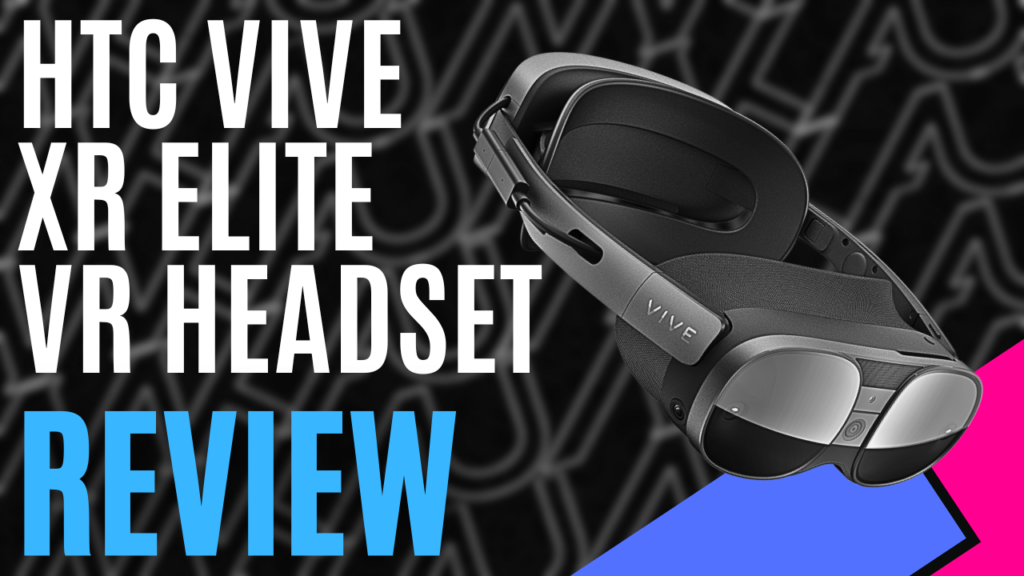
There is no denying that VR has come a long way since it became commercially available to the public. In the last ten years alone we have seen VR headsets become much smaller and lighter, even shedding themselves of the often cumbersome cables. Of the hundreds of companies that manufacture VR headsets, only a few have always stood out above the rest, like Meta and their Quest headsets, Sony with the PSVR and PSVR2 and HTC with the Vive line of headsets. Thanks to HTC, I have spent the last couple of weeks getting up close and personal with their latest headset, the HTC Vive XR Elite.
The review package we were sent included the base HTC Vive XR Elite and a Vive Ultimate 3+ 1 Tracker Kit. Upon opening the very eco-friendly packaging you’ll be greeted with the usual cast of documentation including, a warranty card, quick start guide and safety guide. The box is then opened into three sections, in section 1 you will find 2x USB Type A to Type C cables, a USB Type C to Type C cable, 2 temple clips for use in the glasses configuration, a top strap, and the Battery Cradle. Section 2 houses the 2 rechargeable Controllers and 2 lanyards. Section 3 is home to the brains of the operation, here you will find a microfiber pouch and the Vive XR Elite headset. The Vive Ultimate 3+ 1 Tracker Kit has 3 rechargeable trackers, a USB Type C to Type C cable, and a USB Type C wireless dongle. We were also sent a few body straps to which the trackers connect.
Inspecting the headset for the first time I was immediately drawn to how light it was holding it in my hands. Looking from the front gave me the feeling that I was about to be wearing an oversized pair of aviator glasses. Whilst I very much liked the all-black aesthetic and the finish of the black plastic, the arms felt flimsy and I was terrified of breaking them off. Eager to try out the glasses configuration I attached the arm clips and wore the headset briefly.
This only heightened my fear of breaking or dropping the headset, mostly because it felt so unnatural to be wearing a VR headset like this. The arm clips felt as though they were digging into the side of my temples and the pressure became uncomfortable. I do enjoy a modular design though and found it very easy to change the configuration to that of a more traditional VR headset. With the battery cradle charged and clipped into the arms and connected to the USB C connector on the headset I was ready to get started.

The Vive XR Elite is bursting at the seams with an impressive set of features, none of which would be possible without the hefty processing power of the Qualcomm Snapdragon XR2 processor. For the first time, I was able to enjoy the crystal-clear 3840 x 1920 (combined) resolution without wearing my glasses. Thanks to the Stepless IPD (inter-pupillary distance) and the adjustable diopters on each lens, I was able to get dialled in and read text blur-free as if I had my glasses on. The 16MP RGB camera and depth sensor built into the front of the headset provides a high-fidelity colour passthrough and unleashes the mixed-reality potential.
Outside-in tracking is handled with a combination of a gyroscope, G-sensor and 4 wide-angled cameras. Don’t feel like using your controllers? Go controller-free with AI-driven hand tracking, allowing you to navigate, click, type, drag, and scroll with natural hand and finger movement. Built-in speakers in the headset will keep you engaged in-game without the disruption of having to remove headphones should one of life’s distractions arise. Still not enough features for you? Unlock all of the Vive XR Elite’s potential with optional upgrades like facial and eye tracking and full body tracking.
After a few hours of ensuring everything was charged, it’s time to get to the good stuff. Because this was a review unit I didn’t have to go through the whole setup experience, only needing to set my play area and connect to Wi-fi and I was good to go. Setting up my play space was a very familiar experience and is achieved in almost the same way as the Vive Cosmos. However, being completely wireless it was a great feeling to utilise a lot more of my living area and have a much bigger play space to move around in.
Entering the VR home space for the first time had me stepping into an open-plan virtual home. This home base seemed very minimalist in design and even made me feel a little awe as a giant whale glided by the window when I was looking outside. Front and centre when you arrive you’ll find yourself looking at your menu where you’ll launch all of your apps, access settings and peruse the Vive storefront.
In terms of standalone content that is available on the storefront, it was nice to see a few familiar games like, Toss!, Unplugged: Air Guitar, and Zombieland: Headshot Fever Reloaded, all of which I’ve had the pleasure of reviewing for the PSVR2. This felt like the perfect time to load in and get some great data for comparison.
![]()
I was quite surprised by how close the load times were between the two platforms. Even though the PSVR2 was loading games a little faster, the XR Elite still held its own and felt quite snappy. All three of these games performed just as well between the two platforms, however, this is where I started to notice some of the XR Elite’s shortcomings.
In VR environments you will always have the best experience when you block outside light sources from bleeding into your headset. For me, this outside light leaking into the headset is disruptive and sometimes even produces quite a nasty headache. The included eye gasket on the XR Elite has a lot of coverage but sadly a lot of outside light still bounces in. The only solution for me was to have the headset painfully tight on my head which only caused even more discomfort. Thankfully HTC has managed to solve this issue with the Face Gasket 2.0 which offers better coverage and comfort, sadly I wasn’t able to try this out for myself. I feel that rather than be selling this as part of an accessory pack it should be included with the base package.
Putting the light bleeding aside, the visuals are incredible, and as I mentioned earlier being able to ditch the glasses and simulate my prescription with the adjustable diopters is a godsend. It may not be the 4k per eye resolution I’ve grown quite fond of with the PSVR2, but the Vive XR Elite’s combined 3840 x 1920 resolution still produces an almost indistinguishable display. It is also a significant improvement over the Vive Cosmos visuals, producing much clearer images without the visibility of pixels.
Controller tracking is precise, smooth and accurate for the most part. The only issue I faced with tracking the controllers was the occasional hand clash in Hubris when trying to touch a button on my wrist. This seemed more of a game-specific issue as I didn’t experience this in any of the other games I played. Hand and finger tracking is new to me and took some getting used to. I often would be misclicking and touching things that I didn’t mean to, largely because of my inexperience using this type of tracking. Eventually, I got the hang of it and was having a great time, though it did feel as if there was some slight latency while making use of some mixed reality content.
Busting moves and grooves in Dash Dance was an incredible introduction to using full-body tracking. The Vive Ultimate Tracker kit is incredibly accurate and does a phenomenal job tracking every step, squat, and bend. There didn’t seem to be enough content in the store that supported this incredible tech. Even over on the PC, I struggled to find a great deal of content that supported full body tracking, leaving me feeling it was a bit gimmicky or perhaps still a bit too bleeding edge. I loved the experience and felt incredible after such a great workout, with more support and content it would be a must-have accessory.
![]()
Connectivity to a PC is fast and simple opening up many great opportunities that add even more functionality. With the download and installation of the robust and lightweight Vive Streaming App, you can gain access to your Steam VR library and even stay productive when connected to the Virtual Desktop. Connecting wirelessly to my PC and playing the juggernaut that is Beat Saber was a solid experience. However, I did notice that if I moved around my play space a bit too far from the router it would become much less stable, sometimes even disconnecting entirely. Decreasing my play space a little so that I could be a bit closer to my router cleared up these issues quite nicely, though, I feel that being connected via the Vive Stream Cable would be a much better option here.
Powering this high-performance beast is the 24.32 Wh battery that is built into the battery cradle. On average per play session, this gave me one and a half to one and three-quarter hours of play, depending on how heavily I was pushing the hardware. For some people, this might be a pretty good length of playtime. As for a heavy user like myself who averages 3-4 hrs per session, this was a complete shock to my system. Thankfully the battery does charge quite quickly and if you’re lucky enough to have a spare it’s hot-swappable which will get you back into the game faster. While I understand that powering such a robust unit requires a load of power, it would benefit greatly if capacity was at least double its current iteration.
As someone who gets great enjoyment from a high-quality audio experience, even I must admit that the built-in speakers deliver quite the surprise. The audio quality from these tiny speakers is incredible, delivering top-notch 3D soundscapes while also being loud enough to stay completely immersed without completely disconnecting from reality. I’m certain this also brought much relief to the family, being able to talk to me directly without having to yell or run the risk of an accidental whack from scaring the crap out of me.
Even though the Vive XR Elite drops the ball in a few areas it is clear where HTC are headed with stand-alone VR headsets. I am a massive fan of the modular design and its upgradeability. Despite the shortcomings, this headset is an incredible entry into the stand-alone market and with a bit of work I can see HTC coming out on top and crushing the competition. If high-end performance, stunning visuals, a small form factor and no cables are on your VR bucket list, this is the beast you are looking to hunt down.
Find a great deal on HTC Vive XR Elite and upgrades here -> https://www.vive.com/au/product/vive-xr-elite/overview/

The Good
- Small form factor
- Lightweight
- Stunning visuals
- Upgradability
- PC level performance
- Modular design
- Audio clarity
- Superb outside in tracking
- PC connectivity via wireless and Vive Stream cable
- Optional upgrades
The Bad
- The glasses configuration is uncomfortable
- Battery life
- Hand tracking is laggy
- Lack of content for full body tracking
- Poor light blocking from standard face gasket








